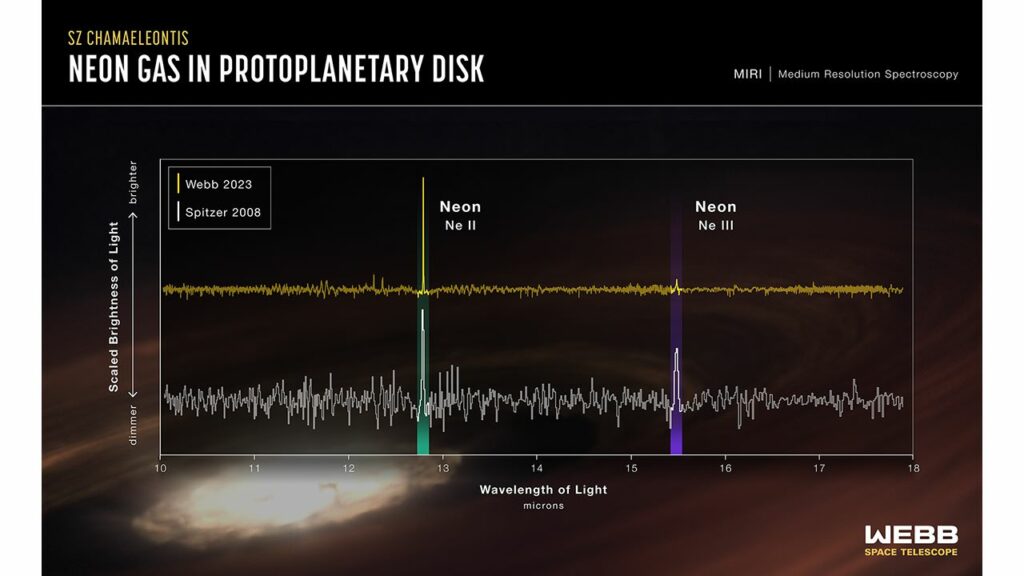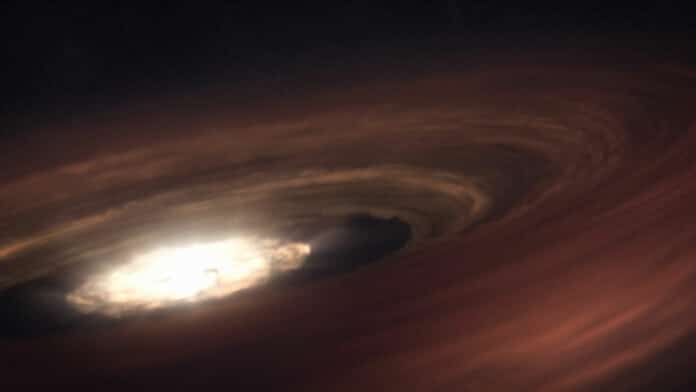The neon signs reveal the planetary system’s future and the solar system’s past. Scientists use neon to measure the amount and kind of radiation entering and eroding the disk surrounding a star.
NASA’s James Webb Space Telescope discovered clear signs of the element neon in the dusty disk encircling the young Sun-like star SZ Chamaeleontis (SZ Cha), following up on a peculiar reading made by the agency’s former infrared flagship telescope, the now-retired Spitzer Space Telescope.
In 2008, Spitzer analyzed SZ Cha and noticed an anomaly: neon readings not found in any other young T-Tauri disk. That was the difference: neon III was detected, which is usually rare in protoplanetary disks bombarded with high-energy X-rays.
This indicated that ultraviolet (UV) light, rather than X-rays, was the source of high-energy radiation in the SZ Cha disk. The UV vs. X-ray discrepancy is not only the only anomalous finding in a sample of 50–60 young star disks, but it also bears important implications for the disk’s lifetime and possible planets.
Variations in the neon measurements between Spitzer and Webb suggest a previously unreported shift in high-energy radiation reaching the disk, ultimately leading to its evaporation and limiting the timescale for planet formation.
Astronomer Catherine Espaillat of Boston University, in Massachusetts, said, “How did we get here? It really goes back to that big question, and SZ Cha is the same type of young star, a T-Tauri star, as our Sun was 4.5 billion years ago at the dawn of the solar system. The raw materials for Earth, and eventually life, were present in the disk of material that surrounded the Sun after it formed, and so studying these other young systems is as close as we can get to going back in time to see how our own story began.”

Scientists studying SZ Cha with Webb found something surprising: the peculiar neon III signature had all but vanished, showing the usual dominance of X-ray radiation.
The scientists believe that a fluctuating wind, when present, absorbs UV radiation and leaves X-rays to bombard the disk, which accounts for the variations in neon signals in the SZ Cha system. According to the team, winds are common in a system containing a recently created, energetic star, but Spitzer observed the system during a quiet, wind-free period.
Co-author Ardjan Sturm of Leiden University, Leiden, Netherlands, said, “Both the Spitzer and Webb data are excellent, so we knew this had to be something new we were observing in the SZ Cha system – a significant change in conditions in just 15 years.”
The team will make more observations to unravel the mysteries of SZ Cha.
Co-author Caeley Pittman of Boston University said, “It will be important to study SZ Cha and other young systems, in multiple wavelengths of light, like X-ray and visible light, to discover the true nature of this variability we’ve found. It’s possible that brief, quiet periods dominated by extreme UV radiation are common in many young planetary systems, but we just have not been able to catch them.”
Espaillat said, “Once again, the universe is showing us that none of its methods are as simple as we might like to make them. We need to rethink, re-observe, and gather more information. We’ll be following the neon signs.”
Journal Reference:
- C. C. Espaillat, T. Thanathibodee, C. V> Pittman et al. JWST Detects Neon Line Variability in a Protoplanetary Disk. The Astrophysical Journal Letters. DOI 10.3847/2041-8213/ad023d
